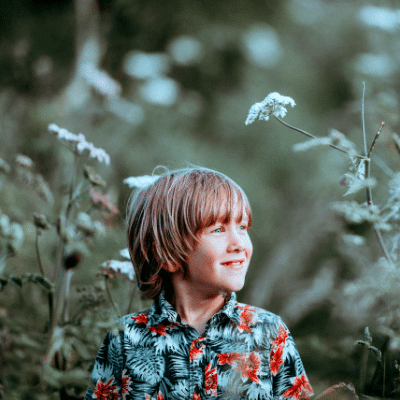

It's a common understanding that adults can greatly benefit from practicing meditation and mindfulness exercises. Whether you already do so as part of therapy, feel it's useful for personal development, or have been encouraged to do it at work, it's likely that you've tried to meditate at least once or twice. But what about mindfulness for kids?
Is mindfulness just for stressed-out, self-aware adults, or do the benefits extend to children as well? Should we be encouraging younger people to practice mindfulness – and, if so, what benefits can they expect to enjoy?
As it turns out, meditation is a wonderful thing for children, and you can start young! This article for meditation for kids will explain whether mindfulness works and how it promotes both physical and mental well-being.
In addition, we'll explain how to teach mindfulness meditation to your children and walk you through a wide range of fun, productive mindfulness activities for kids of all ages.

Mindfulness is all about anchoring yourself in the present moment, stripping away distractions, and focusing the mind at will.
Many adults swear by it, and there is plenty of compelling research suggesting that it boosts everything from empathy to positive thinking in adult minds.
Until relatively recently, however, we didn't have much more information on how mindfulness meditation impacts children.
For example, you might wonder whether children really have the capacity to concentrate enough to learn mindfulness techniques, or whether their lives are sufficiently simple that they don't need these exercises in the way that adult might.
Happily, the latest studies on mindfulness for kids suggest a generally positive impact. We'll consider some benefits below, but in general, meditation is linked to reductions in anxiety and increases in cognitive performance.
Educators and parents increasingly see mindfulness for kids as new skills to boost their happiness, emotional regulation, and self-knowledge.
While it's essentially just one set of techniques, it has wide applicability and costs very little to teach.

An estimated one in five children struggles with some kind of mental health issue.
Whether it's low mood, anxiety or compulsive behaviors, it can be difficult for parents and teachers to find the right interventions.
While medications and counseling can be crucial, mindfulness for kids can really incorporate balance and peace in their everyday lives.
Learning mindfulness techniques at an early age can give them an empowering toolkit when dealing with stress later in life.
The advantages go beyond just boosting mental health, too – here are some great benefits of mindfulness for kids.

Firstly, meditation helps kids exert more control over what they are focusing on at any time.
By focusing on their breathing or on bodily sensations during meditation, they learn how to regulate their own attention.
This can make it much easier to settle down to schoolwork, creative projects, or even just discussions with others.
In particular, children with ADD or ADHD report a noticeable improvement in their attention after learning mindfulness.
This mirrors what we already know about adults, who reliably feel sharper and more focused once they develop a sustained mindfulness habit.

Meditation is famous for helping you to regulate your own feelings.
It isn't encouraged to block out or ignore important emotions, it helps you to accept feelings and move past them.
This can help kids, for whom “big feelings” (like anger and sadness) can sometimes feel like too much to control.
Mindfulness for kids has been proven to have great long-term effects.
Children test as less impulsive, more confident in their self-control, and less likely to have emotional meltdowns.
This is a result that is good for children and parents alike, facilitating positive relationships.

On a related note, mindfulness meditation techniques are proven to help you deal with stress and anxiety.
When they learn breathing exercises and other calming rituals, they have at their disposal the ability to bring themselves back to a calm state at any time.
Once again, this is especially important for children who are already struggling with stress or low mood.
However, we all go through experiences that make us anxious and knowing what to do when we encounter those triggers goes a long way toward helping us to feel centered and capable.
This goes for both adults and children.

Researchers working on the benefits of meditation have noticed an interesting link between learning meditation techniques and having a healthy sleep pattern.
Many children struggle to fall asleep or stay asleep, and yet more report not feeling fully rested on waking.
Natural sleep aids like getting into a routine of practicing a mindfulness exercise just before bed can make it easier for children to fall asleep and can help them to get into a deep, restorative sleep that lasts the whole night through.
Mindfulness exercises can also help children to disconnect from troubling nightmares.

There are lots of factors that influence a child's academic performance.
However, brute ability and genetically inherited intelligence are just two of these factors – we're becoming steadily more aware of just how much environmental factors matter.
One such factor is mindfulness for kids, which steadily creates measurable changes in the brain.
By practicing for just 15 minutes five times a week, kids can enjoy improved memory and problem-solving skills (as well as the increase in focus mentioned above).
These changes can add up to lead to significant, long-term changes in academic performance.

If you think back to when you were a child, you can probably remember a time when you felt “not good enough.”
No matter how loving your family might be, childhood and adolescence are hard and self-esteem fluctuations inevitably result.
Knowing how to love yourself can be hard at times.
Sometimes, difficult experiences (such as feeling humiliated or being bullied) can cement themselves in a child's memory, propping up a negative set of beliefs.
Meditation and mindfulness exercises slow down thinking, helping the child to think more clearly, to trust their own intuition, and to accept themselves.
In fact, some of the exercises we'll look at below are specifically designed with self-love in mind.

Finally, enhanced empathy is another of the measurable neurological changes caused by meditation.
Whether we're children or adults, the more we practice mindfulness the better we get at “perspective-taking.”
In other words, we become progressively better at putting ourselves in another person's shoes rather than focusing on our own unique experiences.
For example, one study at Northeastern University found those who meditate are more likely to help others who are suffering.
In children, performing acts of kindness is wonderful role-modeling for other kids, as well as an innately good trait to cultivate.

You might probably be asking how exactly you should go about incorporating mindfulness for kids in children's lives?
Are the techniques like daily positive affirmation exercises useful for kids, or do children have to use their own techniques?
It's best to start simple, and for short periods of time, as children will gradually build up patience and understanding when it comes to mindfulness works.
Let's start out by looking at two particularly straightforward techniques that any children can learn.
First, mindful hearing is something that even the most restless and energetic child can be persuaded to try!
Set aside five minutes and ask your child to tune into everything they can hear, ignoring everything else.
In the early stages, it can be helpful for them to note down what they hear, in order to keep them on task and keep them stimulated.
A second basic mindfulness exercise for kids who are a little more advanced involves letting them listen to guided meditations.
This will be appealing to children with vivid imaginations.
They will enjoy the exercise in the same way that they enjoy a story.
You can find a wide range of guided meditations for kids online, or you can come up with stories.
The trick is to create a narrative that involves all of their senses.
Try to fully anchor them in the moment and in the images produced by their own minds.
There are dozens of fun, exciting and effective ways for children to practice and refine their mindfulness skills!
Let's take a look at further exercises that they can try. All of these encourage children to focus, tune into themselves and fully experience the present moment which is exactly what mindfulness for kids is all about.
Each of these varies in length, depending on your child's concentration span, age, and experience with meditation.
 Breathing Exercises For Kids
Breathing Exercises For KidsThere are different breathing exercises you can do with children, but they work best if you link them to actions.
For example, you might ask kids to count to five on their right hand as they breathe in, and then count to five on their left hand to breathe out.
You can have them put their hands on their belly to feel their bodies move as they breathe deeply.
You'll need a cloudy but pleasant day for this exercise.
It requires you to take kids outside, let them lie down on the grass (or a blanket), and stare up at the clouds.
Ask them to find and name shapes (in their heads), and to notice how those shapes shift and change with the breeze.
 Yoga for kids
Yoga for kidsStart teaching kids some basic poses that boost mindfulness and flexibility.
Even preschoolers can learn some poses (such as those that mirror animals), and you can find lots of videos online.
Look around the community for local yoga classes for kids, too – these provide opportunities for friendship as well as mindfulness.
Think of this exercise as a kind of “weather report” of the child's emotions. Invite them to describe the dominant feeling they're having.
If they're happy, where do they feel it in their body?
If happiness was a color or a shape, what would it look like?
There are no limits to the creative questions you can ask to help kids get to know and accept their feelings.
 Mindful Walk in Nature
Mindful Walk in NatureDuring a mindful walk in nature, you explore a place quietly and with an emphasis on taking in your surroundings.
To help children concentrate on being in the moment, you might try giving them a mindfulness task (such as finding 10 beautiful things, or 5 objects that look like animals).
This exercise also cultivates gratitude.
A bedtime body scan involves your child slowly thinking about how each part of their body feels.
Typically, they start at the top of the head and work all the way down to the toes.
Ask them to notice exactly how each piece of themselves feels, and to focus on letting each body part relax.
Often, this gets kids into the perfect mood for sleep.
 Explore Gratitude
Explore GratitudeFinally, gratitude exercises are diverse and are a great aspect to explore when looking into mindfulness for kids.
There are many benefits to having a mindset that promotes gratitude.
You might involve your child writing down something they feel grateful for at the end of each day, and adding it to a jar.
At the end of the month, they can reopen the jar and reconsider all their special experiences.
Other kids may get more enjoyment out of just listing three things they're grateful for before they go to sleep.
Make sure they know these don't need to be big things!
While all of the mindfulness exercises we've explored can go a long way towards making kids happier, more emotionally resilient, more focused, and more mentally sharp, self-hypnosis can take this one step further.
Children often respond to hypnosis recordings immediately, as they have vivid imaginations and high levels of receptivity to suggestion.
Self-hypnosis for kids can reinforce everything from self-esteem to anxiety reduction, concentration, and the cessation of unhelpful habits (such as biting their nails).
Most importantly, self-hypnosis for kids use techniques that are enormously relaxing and help them get into the habit of entering the receptive, calm state associated with mindfulness.
